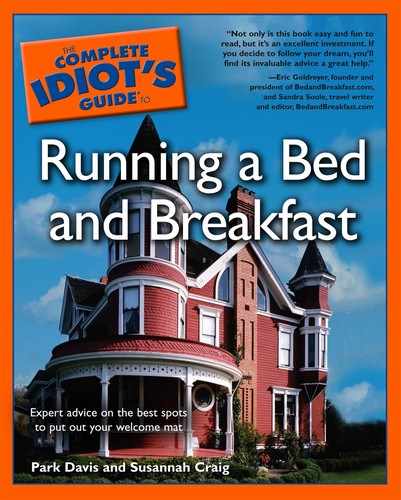
Chapter 10
Marketing 101
In This Chapter
• Developing a marketing plan that you can pull off
• Working on local and global levels to promote your B&B
• Brainstorming cheap marketing tricks
When we first outlined the book, we had an entire chapter devoted to advertising. We soon realized that it didn’t make sense. B&Bs do advertise, but mostly in magazines and newspapers, and usually only at the startup of a business. You won’t be hiring an advertising firm to create a nifty national or even local television ad (unless you’re a full-service inn with some extra cash flow). We do cover advertising in this chapter but only as a small part of the overall marketing plan. As Park has learned over the years and other B&B owners have told us, the best money you can spend is on your Web site and your brochure.
Attracting guests will be your first challenge as a new owner. Making a good impression on those guests so they’ll spread the word is an even bigger challenge, but it comes later.
Before You Write That Brochure
You’ll probably be tempted to write a brochure right away. Having one to hand out to people is a good thing, but don’t make it your first project, especially if you don’t have good photos yet or you think some vital information might change (such as the phone number). If you’re itching to start promoting while renovations are still going on, work on the Web site. Changes can be made to a Web site within a day but a brochure will be around for a while. Put up pictures of your house in progress; get

Inn the Know
Before you spend money on a brochure that you might end up using as gift-wrap paper, spend some time researching your market and working on a plan. Then put those fancy photos and that snazzy verbiage into a brochure that you’ll love!
people excited about the developments and what’s to come. Give some thought to any promises you might want to make on your Web site about a completion date. If the house isn’t ready when you thought it would be and you have rooms booked, you’ll have to do some fancy dancing on the phone, and could even lose clientele altogether. Add a few weeks or even a month to your finish date and you’ll spare yourself and everyone else some unnecessary anxiety.
Research: Not Just for Grad Students
Collecting market research is not done in an afternoon and it’s not done solely for the marketing plan (a component of the business plan, covered in Chapter 8, “The Business Plan”). You may have already done some or most of your research to use in your marketing plan by determining your room rates (see Chapter 7, “All About Room Rates”), deciding on what amenities to offer (see Chapter 13, “Getting the Most from Your B&B”), and establishing what services will best suit your clientele (see Chapter 18, “Guest Services with a Smile”). All these things are part of market research and will help you focus in on your clientele; the first step in trying to reach them. Expending effort to reach all market sectors will be a waste of time and money. Be realistic. For example, if you’re in a rural area that attracts mostly families because of Sal’s Wacky, Wild Water Park, you won’t have many older couples planning visits there.
Conversely, don’t feel completely locked in to servicing only the typical clientele who visit your area. If there’s a variety of lodging choices for travelers to choose from, you can target a more specific segment of the market—conducting market research before you open for business is even more critical in this case. You’ll need to uncover the types of guests that other properties are targeting and then decide which area of the market you’ll focus on. For example, if you’re in an area of five-star hotels, don’t feel as if you need to rise to their level to attract guests. Go for the spillover. Try to get the guests who want to come to your area but can’t afford a full-service hotel. Just make sure that they don’t expect five-star-hotel services! Be clear about what you do offer, and play up the fact that, because you’re not a hotel, you can provide an informal, one-on-one atmosphere.
Word of Mouth: Promotion You Can’t Buy
When we asked B&B owners and inn-keepers for their best advice on where to spend marketing money, they said, “put it into your house.” That doesn’t mean that you shouldn’t do any marketing at all! If that were true this chapter would be very short.
What your faithful legion of B&B owners is saying is this: Make sure that guests leave with good stories to tell. Having guests spread the word for you is the best way to generate business. People who take trips to new destinations will ask friends and family who’ve been there what the best places are to roost. If a travel writer stays with you, give him or her the best room; it’s a great payoff for what the writer may report on your inn. If your place is at the top of the list among guests and reviewers, you’ve reached potential clientele without spending any marketing dollars at all.
The Marketing Plan
As with almost every part of the B&B business, marketing is a never-ending project. As there are many different ways to get your name out there and lots of things to think about at once, marketing can seem overwhelming, especially at first. Break up the general project of marketing into pieces so you can accomplish them step by step. Think of each step you take as a layer of lasagna. As you layer each scrumptious piece you build a meal, a whole package. When you serve a portion of it, everything you put into it is there, even the stuff at the bottom. Marketing is the same way. You start out with a few projects and then keep adding more, but you retain those first few projects unless they turn out to be unsuccessful (the bottom burns).
Create a marketing plan that is realistic and will fit into your budget. The most difficult thing about beginning to market a product is that you’ll be “guestimating.” Even with all your research, you won’t really know how well you’ve reached your market until guests start to show up at your door. As you go along it’ll get easier because you’ll be able to look back at what worked and what didn’t work, and you’ll know where to put your energy and money in future efforts.

Inn the Know
Your marketing plan will be part of the business plan that you hand out to consultants, potential investors, lending institutions, and others such as your insurance agent. Make sure that it’s polished and realistic.
Put It on Paper
If you don’t have a marketing background or any experience at all in marketing, don’t panic. You might not know where to begin, but don’t let that stop you. Marketing is as simple as writing down your goals, formulating a plan of action, and then sticking to it. Set reasonable goals and see them through.
Start out by listing your ideas for marketing and promotion. Don’t go in any particular order; in fact, write down those ideas as they pop into your head or as you “borrow” them from other B&Bs, Web sites, and us. Don’t think about cost or whether they’re plausible or not just yet (we’ll get to that). Here’s an example list:
Design logo.
Have sign built and stationery printed.
Have photos taken of building and rooms.
Contact Chamber of Commerce and other local groups to gather info on area businesses and events for upcoming year.
Write out plans for connecting with local events.
Surf Web sites and homepages for promotional ideas and tricks that other B&Bs use to market to their clientele.
Develop layout ideas for Web site.
Hire Web site designer.
Assemble brochure and room rate info.
Decide on hiring a designer or work on computer for brochure and room rate card.
Have brochure and room rate card printed.
Create five ideas for an opening day promotion; develop plans for spreading the word about it locally and beyond.
Choose three main visitor attractions close by (such as a historical museum, hospital, or state park) and create ideas for spreading the word to their visitors.
Find 15 Web sites that you would like to be linked to or listed on.
Get advertising rates and lead time info from local publications.
Pick 10 guidebooks that you want to be listed in and develop a plan for reaching publishers.
Pick 8 to 10 periodicals (local and national) you’d like to be reviewed by and develop plans to entice them in your direction.
Create five ideas for slow season promotion; develop plans to spread the word about it locally and beyond.
Spend a couple of days coming up with ideas before you move on to the next steps: establishing goals for the year and then creating your marketing calendar. Writing out a list of ideas before you set your goals for the year probably seems a bit backward, but going backward actually will give you a better idea of what you want to accomplish as you go into your first year and beyond. You’ll have a ton of marketing ideas that can’t all happen in the first year. Writing them out, though, will give you a wider view of what you want to accomplish in the long term.
Marketing Calendar: 2001 to 2002 Season
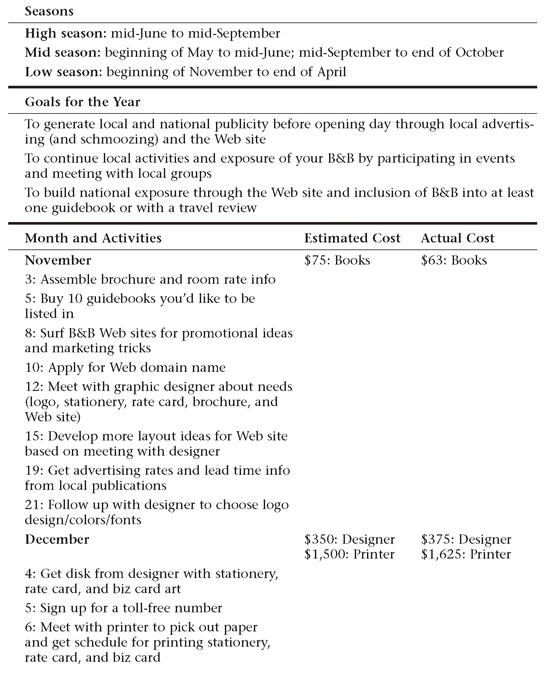
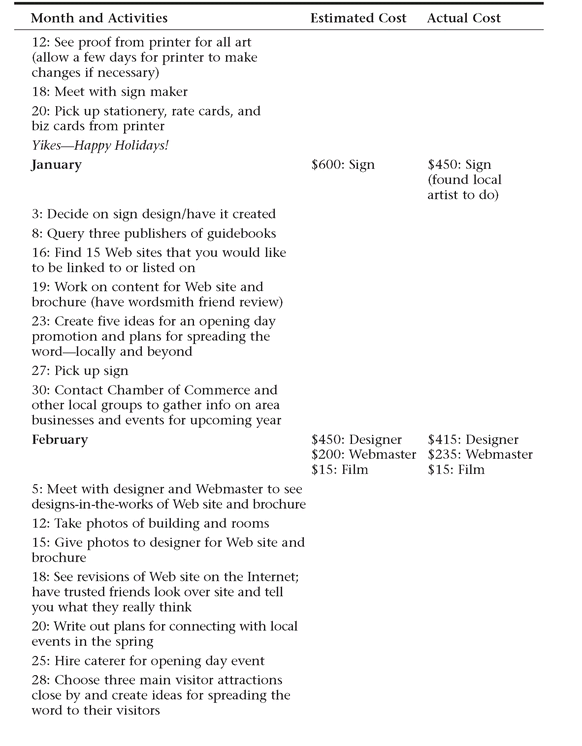
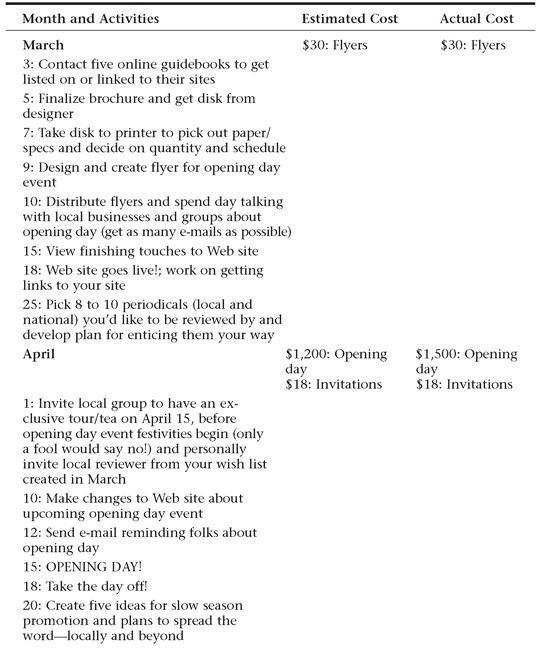
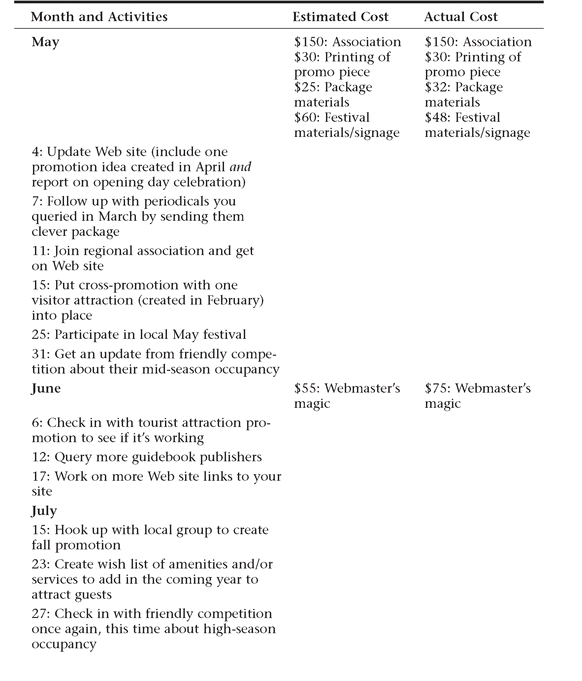
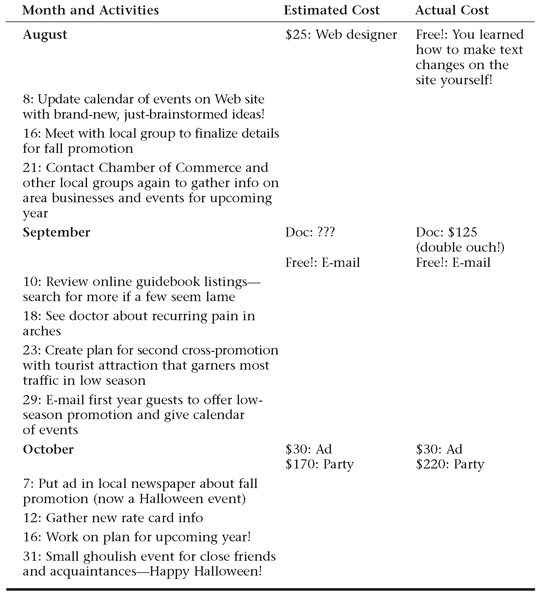
To determine your marketing budget for the year, look over your list and make notes about even the smallest costs (such as postage for letters and long-distance phone calls to contact publishers of guide books). Web site design and printing up the brochure and stationery will be some of your biggest costs for the first year but they’re all imperative. If you look at your projected costs for marketing and decide that you can cover only your essential projects in the first year, you’ll need to think of cost-free ideas to spread the word such as finding more places to leave your brochures and scouring the Web for free listings.
Working with the Locals
As your life will revolve more and more around the house and everyday operations, don’t forget to keep your eyes peeled for local happenings. Make it a point to get out and talk to other business owners and attend events such as fundraisers and community celebrations. You won’t be able to get out of the house as much as those nine-to-fivers, so be sure to read your local papers and stay in touch with people who know what happens in the town.
Being tuned in to the locals will help your business in more ways than one. You’ll be in on the talk of the town, will learn how certain folks would like to see it grow (or not grow), and what new businesses are in the works. You’ll have a better clue to the town’s direction and whether it’s actively reaching out to the tourist trade. You might have to get more involved in town politics than you expected. If your area could offer more to tourists than your town is promoting, it might be up to you and other businesses to bring it to the attention of town officials.
Seasonal Marketing
Paying attention to marketing your B&B in your highest season is important, as you’ll be competing with others; but your biggest challenge will be getting clientele to come your way in the lowest season. Try out one project or promotion for that period that won’t cost you that much, or work with other local businesses to create an event weekend. Plan ahead for it; if you don’t have time to plan during your high season, plan a big event for the coming year. That way, you can tell more guests about it early and follow up later with a mailer or e-mail. Be sure you set aside funds for a low season event, as it will inevitably cut into your bank balance the closer you get to the big day. You’ll need more money for food, Web site changes, and maybe a last-minute flyer.

B&B-eware!
If you don’t have a property that’s conducive to an event, don’t kill yourself to come up with one. A cabin in the Ozarks wouldn’t be the place for a festive, cabaret weekend. If your weather’s lousy during low season, you’ll have a hard time getting people to your door no matter what you do. Instead, use your slow time to work on local promotions, your Web site, and marketing plans for the coming mid season.
B&B Basics
As in our marketing calendar example, designing your logo and printing stationery, business cards, and the brochure should be the first things you do.
Don’t Go Without a Logo
Even if you hire someone to design a logo for you, do some preliminary sketches of your own. Including your B&B’s name as part of your logo is always preferable so that the two are connected. Many B&Bs use only the name as a logo, and that works well, too. A graphic designer will have a variety of fonts and styles, as will some basic computer software programs such as Microsoft Publisher.
Choose a logo that will look good everywhere—in large and small versions. Choose colors that suit your house, your theme (gold, black, and red for the “The Red Lion Inn”), and your tastes. Stick with clean lines and eye-popping but simple graphics. Create a logo that people will remember and that suits your style and the style of your house.
Try out a couple of designs and ask people who will give you honest opinions which ones they prefer. Make sure you like your logo—a lot—before you start spending money to have it plastered everywhere you look.

Inn the Know
You’d love an old sailing ship for your logo, but how will it look on a three-foot-wide sign? Draw it in different sizes and then enlarge your drawings on a copier. Thick lines will look great on a large sign but how will they look scaled down to an inch? That intricate design might look great on stationery but be incomprehensible on your sign.
Stationery and Biz Cards

Shoestring Solution
When you create your stationery and business cards, be sure the information won’t change. Also, you might be tempted to order in bulk to save money but you probably should order the minimum quantity at first. You might like the design today and hate it next month.
When you have a logo you love, head to a local printer for stationery. You’ll be able to pick out text and colors that match your logo and the paper it’s printed on. If you’re computer-savvy, try out different fonts next to your logo and B&B name to see how they look. Take your best bets with you to the printer to have them matched up. If you’re really handy with the computer, you can have your logo scanned in on disk and use it to create your own letterhead and business cards. You’ll need a laser printer that will make your stationery look professional and card stock your printer can handle.
Make sure you see what’s called a “proof” of everything before it goes to print. Look over the proofs to make sure all the information is correct and the stationery or card looks the way you expected it to.
An Eye-Catching Sign
Check your local bylaws before you go out and order a six-foot neon yellow sign with flashing red letters. Okay, that’s an unlikely choice for a B&B, but you get the idea. Some places will have limitations on the height of the sign from the ground or its dimensions; or you might not be permitted to have a roadside sign at all.
When you consider your sign’s design and where to put it, take a good look at your property and the neighbors’. Do a couple of drive-bys to make sure that the sign can be seen from as far down the road as possible. If you’re in a four-season area and you’re having the sign created in the dead of winter, will it be covered with summer greenery in the spot you’ve chosen? Could the greenery be cut back? Take all the elements into account; if you’re on a windy hill, pay the extra bucks for an ultra-sturdy sign.
The Brochure
Any brochure should be enticing, energetic, short and sweet, colorful, and up to date. Use language that gets your point across, is clear and concise, and gives potential guests a reason to take another trip so they can stay with you.

B&B-eware!
Stay away from cutesy language. Be careful not to oversell your property or what you offer. You’ll want guests to arrive expecting what they saw and read about in the brochure. Write the text and then put it down for a few days. When you go back to it you might find that the language doesn’t convey the feeling you thought it did.
Always have someone else read over your brochure for mistakes before you send it to the printer, and then again when you get the proof. Enlist as many editors as you can to cut down on the possibility of errors.
Here’s a checklist of things to include in your brochure:
• All address and contact info, including e-mail and Web site
• Description of your place, type of breakfast served, any historical or interesting facts, and the best attributes of your location
• Directions to your place from all major highways or a local map
• Information on all of your rooms including amenities provided in every room and descriptions of each individual room
• Pictures of the front of the house and backyard sitting areas (if possible) and pictures of your rooms that will represent your B&B most accurately

Inn the Know
If you include photos of your rooms, make sure you show both your grandest room and your quaintest. Showing only your top-selling room will mislead guests. If you can’t show a range, or if you’re planning to change the rooms, keep room photos out of your brochure. Instead, put in photos of the exterior of the house, the back gardens, and the porches. Direct folks to your Web site for room photos.
Photos can lure guests to your B&B but they have to be true representations of it to make them glad they chose it. If you don’t provide fresh flowers in the rooms, don’t have them in a guest room photo; put them in the photo of a common room instead. You can spice up a guest room by draping a terry cloth robe over a bed or highlighting a cozy corner with a favorite chair. Just make sure that photos are not too dark or too light so that they’ll reproduce well. If it goes with your gimmick (such as an Old West theme) choose black-and-white or sepia photos; even then, it’s best to have some color photos, too. People want to see the true look of your place, which means color photos—and no pencil sketches.
The Next Level
If you’re eager to place a national ad and have a Web site, too, but you don’t have the green to do both, choose the Web site. One ad in a national magazine can cost as much, maybe more, than initial start-up costs of a Web site. One national ad might not bring you the extended exposure that a whole bunch of less expensive Web site links can bring.
Your Own Web Site
The Web site will be your biggest marketing weapon. You can update it regularly, provide lots of photos and room rate information, and accept reservations through e-mail. You can send potential guests to your Web site for more detail than you can give them over the phone. You can promote the site in your brochure and on your business card; and in stationery, flyers, mailers, invitations, listings in local event publications, and other printed materials.

Inn the Know
Having a Web site is not enough if no one knows it exists. Contact as many Web site hosts as you can about getting listed and cross-linked to their sites. Start with your area and state Web sites, and branch out from there to national sites (such as www.bandb.about.com). When you pay for listings, be sure to choose those that will reach your target market.

Shoestring Solution
Be sure to find out how your Webmaster and designer set their fees. They might charge a flat fee to get the site up and running and then hourly fees to make changes. Save yourself some dough and submit changes in bulk. If you call your Webmaster to make little changes here and there, you’ll end up shelling out more.
If you’re not sure where to start in designing a Web site, spend a good amount of time looking at what everyone else is doing. Print out pages from Web sites that you like and make notes on what would work for yours and what you would do differently. If you hire a Web designer, take the printouts along with your ideas for layout to your first meeting. Your designer will tell you what’s possible within your budget. You then can decide what to incorporate and what to save for later on when you have more funds.
When you’ve settled on an official name for your B&B, it’s a good idea to register your domain name right away. Some sites such as www.alldomain.comwill let you search free for domain names to make sure that your chosen one has not been taken (and it most surely will be, so have backups and variations ready to go). Choose a name that’s simple and memorable, and matches, as closely as possible, the name of your business.
If your budget doesn’t allow for an expensive site, start with a homepage and work your way up. Find a reputable Web site designer who also is a Webmaster or knows a good one. The designer will create the pages of the Web site (and help write it if you like) and the Webmaster will get the site “live” on the Internet. Getting your site on the Internet is complicated. You’ll want a Webmaster that knows how to get your site listed on all the major search engines. If someone types in the keywords “Connecticut B&B,” you’ll want to be at the top of the search results (that is, if your B&B is in Connecticut). A good Webmaster can make it happen.
In addition to the information that you’ll include in your brochure, add the following to your Web site:
• Room rate info: Provide a range if you expect your rates to fluctuate depending on local events (such as concerts or conventions)
• Reservation form so that guests can check for availability through the site
• Photos of every room and details on what each has to offer
• Local map with area points of interest; pictures of downtown areas and most-visited sites are great
• Restaurant and entertainment suggestions
• Some other things such as gift certificates (sent via e-mail) and a monthly newsletter are items you can consider adding later on
Choose 100 to 150 words on your top page as your most important key words. When someone types in a broad search with key words such as “Connecticut B&B,” their results won’t come back with every B&B Web site in Connecticut. Computers are not that smart. A search finds Web sites that have the actual words “Connecticut” and “B&B” listed in the uppermost 20 percent of their top page. If your Web site is in Seattle and you don’t have the words “Seattle” and “Bed and Breakfast” or “B&B” at the top, you’ll be overlooked. Try to choose your 100 to 150 words carefully, putting the most important ones up front (location) and then following with descriptions of area events and attractions.
• Updated schedule of events. It’s best to do this for several months in advance so you’re not updating every week (it also will save you on Webmaster charges).
• Extras on a secondary or back page: photos of you, your staff, and pets; a brief background piece on how long you’ve owned the place and what you did before owning it (include things that relate to service and lodging); a “meet the staff” element if you have more than two staff members; and a longer description of the history of the house and the area (pictures of your place with previous owners are great for really old houses).
Make sure that visitors to your site are not tripping over the secondary information (photos of you, history of house, and so on) to get to more pertinent stuff, such as rates. Spend the extra money to have the Webmaster create buttons that lead to separate pages where people can click on each topic and quickly get to the information they’re after. If they have to scroll down one continuous page to get to what they want, they’ll go elsewhere. Have a professional-looking Web site that is easy to navigate so you grab attention instead of losing it.
Hometown Advertising
Just because you have a sign out front doesn’t mean that everyone will know you exist. Spend some time reaching out to locals so they’ll spread the word to out-of-towners.

B&B-eware!
Make sure you update your Web site info regularly, especially after a promotional event is past, you’ve changed your room rates, or redecorated a room. There’s nothing worse than visiting a site with old information, or one that says “last updated September 1996.” Guests will want to be sure that a place is still in business.
Advertising in a local paper is a great way to announce an opening day or event. Invite townfolk in for an open house tour and serve light refreshments. You won’t get the whole town at your doorstep but you will get those who are active in town events (especially those who received your personal invitation as well; make sure you don’t leave anyone out!).

Coffee Talk
“The very best thing that we did in the beginning was to invite the staff from the Rockford Area Convention and Visitor’s Bureau for a breakfast. What rewards that produced within days!” recall Ken and Karen Sharp, owners of The Barn of Rockford Bed and Breakfast in Rockford, Illinois. “They have remained wonderful supporters and we still invite them over yearly for a big breakfast as our way of saying ‘thank you.’ Word of mouth is still the best advertisement! We have people who come out from Chicago who tell their relatives in New Mexico, and so on. It becomes a very small world! That’s why it is so important to do your very best with everything. You are your best advertisement!”
Take an ad out in the Yellow Pages under accommodations, bed and breakfasts, inns, hotels, lodgings—whatever category works best. If you have a business telephone line you will likely get a free listing (not a display ad, which is costly and not cost-effective) in your local edition of the Yellow Pages. If you’re located outside a city but within the same area code you might ask to be listed in the bigger county edition to obtain greater exposure to those looking for a weekend getaway. Larger areas may have separate listings for B&Bs, guesthouses, inns, and the like (or just “lodging”) so make sure that your listing is in the desired section. Don’t forget to include your toll-free number (keep reading for more on getting one). Continual advertising in a local publication is a waste of money. Concentrate instead on getting involved in local events and activities to increase your B&B’s visibility in hometown circles.
Distribute your brochures around town where they’ll get picked up by potential guests, not in places where they’ll get picked up and tossed or just gather dust (such as in a local hangout that tourists wouldn’t go near). First try to place them with travel agents who are geared toward bringing tourism to your area, rather than booking vacations for townies. Leave brochures at the Chamber of Commerce, tourist information centers, and trade shows; and take them to other local businesses whose business cards or brochures you’ll want to display for your guests. For future planning, keep track of how fast the brochures disappear from each location.
Advertising Nationally
Advertising in Travel & Leisure or other national periodicals is fine for resorts and hotels (and maybe some large inns) but not worth your money. They are extremely expensive and you’ll never know if you reached your target market.
To reach a national audience, your best bet is getting listed in guidebooks. Some will not cost you anything to get listed except the time and energy you spend to get noticed by the author. Others will ask for a fee that could range up to $500. You’ll have to meet a certain criterion to get into any guidebook; this will vary for each publication. Getting into an independent publication (those not attached to an association) is a real coup and could generate future listings in other guidebooks. Authors of guidebooks watch their competition closely (just as you do) and sometimes will approach properties listed in other books to include them. If you do list in national publications, you’ll definitely need a toll-free number.

Coffee Talk
Sam and Richard Corcoran, owners/inn-keepers of Hell’s Blazes in Old Mystic, Connecticut, suggest spending advertising dollars on a toll-free number. Getting a catchy one like the one Hell’s Blazes has—1-888-MY-DEVIL—is even better. “People who are looking to book their weekend while at work will call a toll-free number to avoid making long-distance calls on the company dime. You’ll pay for each phone call but the lure of a toll-free number will pull in a lot more business than advertising will.”
It’s wise to contact guidebooks before you open for business. You might not get a response or a visit from the author for a few months anyway, and it could be a year before the publication hits stores. Guidebooks put out by associations can be considered paid advertising because paying members are automatically listed; they also enjoy access to their other perks. See Chapter 11, “Networking Works,” for more on getting into guidebooks and joining associations.
There are a ton of elements to successful marketing, which include developing a useful plan, creating an eye-catching logo, and designing a Web site that really stands out. You don’t need a degree in marketing to spread the word. Your primary goal as a new inn-keeper should be to find your core market—and then go get ’em!
The Least You Need to Know
• Develop a first-year marketing plan that fits your budget, and initiate projects you can successfully accomplish that year.
• Designing a logo and getting stationery printed are essential to a B&B startup.
• A good Web site is your best marketing tool because it can be updated regularly and can provide more information than a brochure.
• Getting listed in the right guidebooks is a great way to get your B&B on the map.
..................Content has been hidden....................
You can't read the all page of ebook, please click here login for view all page.
